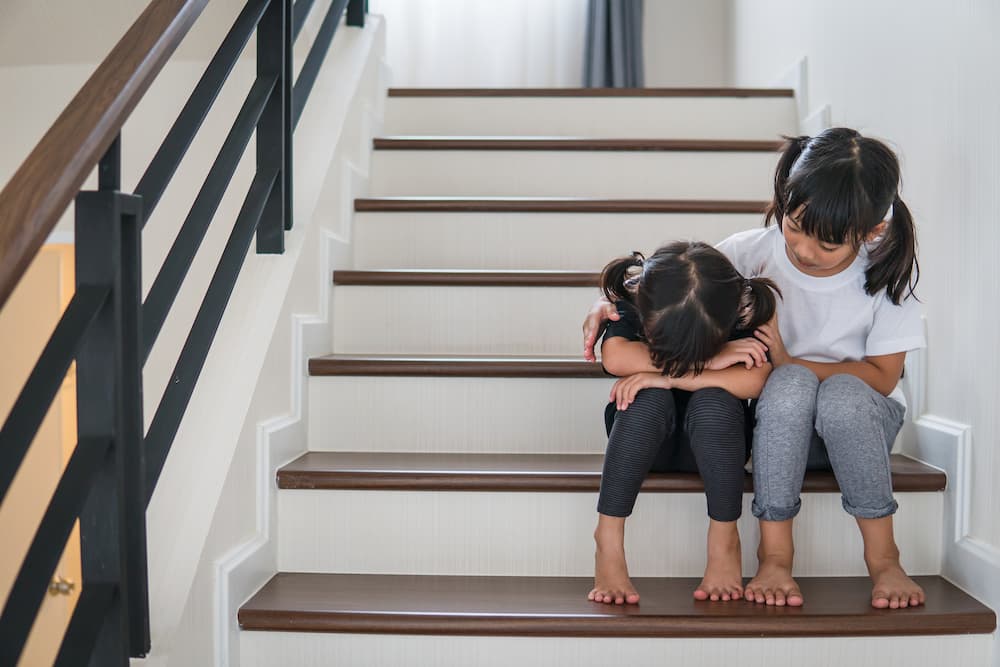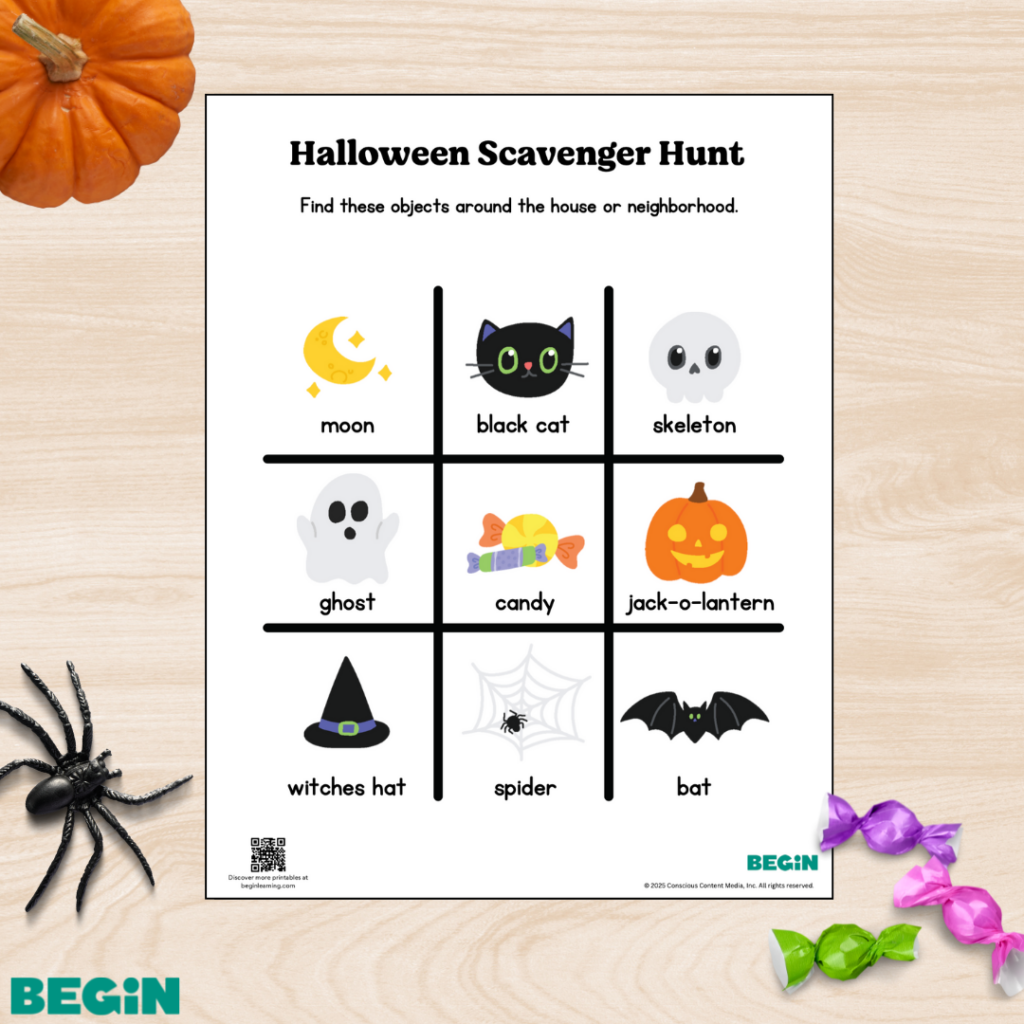Empathy is about imagining how someone else feels and even putting yourself in their shoes to experience the feeling, too. It is one of the most critical social-emotional skills for kids to develop.
Asking a friend if they are OK is one example of empathy, and offering that friend a favorite toy when they’re upset is another. In both cases, a conscious decision is made to offer support to another person.
Kids with well-developed empathy skills are calmer, more emotionally resilient, and have healthier relationships with friends, teachers, and classmates.
Developing empathy is part of building collaboration skills, one of the research-based 6Cs (Collaboration, Communication, Content, Creativity & Curiosity, Critical Thinking, Confidence) at the heart of the Begin Approach to helping kids thrive in school and life. Let us help you get to the heart of empathy-building with strategies to help you teach it to your child.
The Short Cut
- Empathy, the ability to understand how someone else is feeling, helps develop collaboration skills, is one of the 6Cs that lead kids to thrive in school and life.
- Kids usually start to show empathy between ages two and three.
- Teaching kids empathy is important because it helps them develop better relationships and communicate more effectively.
- Parents can help kids develop empathy by identifying and talking about feelings, asking kids to imagine how someone feels when playing pretend, and praising kids for showing empathy.
- Playing games and engaging in activities focused on empathy are a fun way to build this critical, lifelong skill.
Table of Contents
- What Is Empathy?
- Why Teaching Kids Empathy Is Important
- Strategies for Teaching Kids Empathy
- Activities for Teaching Empathy to Kids
- Teaching Kids Empathy with Begin
- Frequently Asked Questions
What Is Empathy?
At its heart, empathy is one of the main drivers of kindness in children. It’s what inspires the kid who brings a toy to a crying younger sibling, cheers up a sad classmate, or makes tea for a parent who’s sick in bed. Teaching kids empathy helps them understand and care about others.
While empathy is essential, it doesn’t always come easily to young children. Empathy requires both imagination and perspective-taking. In fact, empathy can be divided into two categories:
- Cognitive Empathy is the ability to understand someone else’s emotions and why they feel the way they feel. Even if you haven’t experienced the other person’s situation and resulting emotions, you are able to imagine them.
- Emotional Empathy means feeling what someone else is feeling. It involves tapping into the same (or similar) emotions so you can share their experience with them.
You have to be able to see things from another person’s point of view and think about how you would feel in their situation. For inherently egocentric toddlers this can be extremely difficult, but as they grow, being empathetic becomes easier.
As a result, empathy might look different at different ages. Two-year-olds may start to notice when others around them are upset or hurt, whereas by age three they might begin to actively comfort a friend or family member who is upset.
As children age you will see them start to understand more complex or subtle emotions in those around them. Developing empathy for others is a process that begins in toddlers and continues throughout a lifetime.
Why Teaching Kids Empathy Is Important
When your child learns to step into another person’s shoes and see the world through their eyes, good things happen. A stronger ability to empathize leads to:
- Improved relationships with family, friends, and classmates
- A greater ability to resolve conflicts
- Higher levels of cooperation
- Being a better communicator
- More resilience when facing problems
- A stronger sense of self-awareness
- The ability to maintain friendships
- More acceptance of different perspectives
- Willingness to ask for help
In addition, this collaboration skill can significantly impact your child’s success throughout their life. Empathetic adults tend to be more successful in their careers. They’re better leaders, and they make better decisions.
The good news is that parents and caregivers can help their children understand how others are feeling. To assist you with that, let’s look at five different ways you can help your child become more empathetic.
Strategies for Teaching Kids Empathy
1) Talk About Feelings

Make conversations about feelings a regular part of your family culture from when your child is at a young age. When you do this, you help them become more aware of their own emotions and the emotions of others.
You can start talking about feelings with your baby or toddler by using simple terms to describe your emotions. For example, “I feel happy” or “I feel surprised.”
As they get a little older, you can help them better understand more complex emotions with phrases such as, “I feel frustrated because I can’t figure out this puzzle.”
Using age-appropriate language to connect what you’re experiencing to what you’re feeling is one of the best tools for teaching kids empathy.
At this age, you can also talk about the emotions you see in others. You might say, “Grandma looks sad. I wonder why.” Then, you can ask your child for their input. This helps them recognize that other people have feelings, too.
In addition to talking about your own feelings and the feelings of others, ask your child how they’re doing. Listen to what they say, and don’t invalidate their feelings or tell them they shouldn’t feel a certain way. Instead, just listen and offer support.
Try echoing your child’s feelings without judgment (for example, “Oh, I see. You feel really frustrated because your blocks keep falling over.”). This can help your child feel understood, and will also help them understand their own emotions.
Also, avoid looking for ways to “fix” your child’s problem or emotions, as this can also invalidate their feelings. If they want suggestions, that can be your next step, but let them ask first.
Don’t shy away from talking about intense emotions. Your child needs to learn that it’s OK to feel really angry or sad sometimes. Let them know that there are things they can do to recognize these feelings and manage them (e.g. hugging a toy, belly breathing). Help them practice these techniques, and eventually they’ll be able to do them on their own.
The more your child hears about different emotions, the better they’ll be at identifying them in themselves and others.
2) Role Play

Role-playing is a type of pretend play that allows kids to explore different emotions and situations. It’s a great way to help them understand how other people might feel in various circumstances.
When role-playing, encourage your child to imagine how someone else might be feeling. Ask them what they would do if they were in that person’s position.
You can role-play different scenarios with your child. Pick simple events from childhood for your inspiration.
For example, pretend you’re both at the park. You take on the role of a child who didn’t get a turn on the swings. Your child is the empathetic bystander who comes to help.
Once you’ve established your roles, encourage your child to imagine how you’re feeling. This teaches them to take their own knowledge of feelings and apply it to someone else.
If your child isn’t quite sure what to do, switch roles. As you’re playing the part of the empathetic bystander, you can model what it looks like to pay attention to the needs of others.
You can also use puppets or stuffed animals to act out different scenes. This can be helpful if your child is shy or has trouble putting themselves in someone else’s shoes.
3) Identify Feelings in Books and Pictures

Books are a great way to help kids develop empathy. And reading together can open a whole new world of discussion about social-emotional skills.
As you read, point out the different emotions the characters are experiencing. You can also ask your child how they think the characters are feeling by looking for clues in the pictures.
Throughout the story, talk about how the characters’ feelings change over time. This encourages your child to start thinking about how others might feel in different situations. They can also start connecting how the words and actions of others have an impact.
There are so many great books you can use to teach kids about empathy. A few of our favorites include:
- The Way I Feel by Janan Cain
- My Friend Maggie by Hannah E. Harrison
- Adrian Simcox Does NOT Have a Horse by Marcy Campbell
- The Rabbit Listened by Cori Doerrfeld
- You, Me and Empathy by Jayneen Sanders
These books can each spark discussions about feelings and are good to read over and over again.
4) Offer Praise
Whenever your child shows empathy toward others, give them specific praise for their efforts. For example, if you see your child sharing their toys with a friend, tell them how proud you are of their thoughtful action.
Explain that because they were considerate of their friend’s feelings, they made that person feel happy. This positive reinforcement helps your child realize that their actions are valued. It also motivates them to be more empathetic in the future.
When your child recognizes firsthand how their actions can make a difference in someone else’s life, it helps them understand empathy. This allows them to see themselves as a kind and compassionate person, too.
Additionally, offer praise anytime you see your child trying to show empathy, even if they don’t get the desired result. This lets them know their effort is what really matters.
5) Keep Empathy Expectations Age-Appropriate

Toddlers aren’t known for being empathetic. At this age, it’s natural for them to be more concerned about themselves.
However, that doesn’t mean you shouldn’t start teaching kids empathy when they’re young. It just means you need to be realistic about what you can expect from them at this age.
For example, if your toddler is struggling with big feelings, don’t expect them to stop screaming to try to understand how their behavior is making you feel. Instead, focus on allowing them to express their emotions in a safe space, and then validate those emotions.
Kids who don’t understand their own feelings can’t yet understand the feelings of others. So, helping your toddler develop self-awareness is an important first step in teaching empathy.
As they get older, their capacity for empathy increases.
By the time they start school, most kids can understand and empathize with the feelings of others. At this point, you can start expecting them to think about how their actions might affect others. You can also teach them specific skills for managing emotions and handling conflict.
But remember that kids are kids. They aren’t going to be perfectly empathetic all the time. Just like adults, they’ll have good days and bad days.
The important thing is to keep encouraging them to think about the feelings of others and to be kind. They’ll get better and better at empathizing with others the more they practice.
Activities for Teaching Empathy to Kids
Experiential learning is one of the best ways to learn anything, and it’s especially effective for empathy-building in kids. Activities and games that engage the whole child—cognitive, physical, behavioral, emotional, and social—create an experience that resonates.
We’ve put together five activities and games that will make practicing empathy fun, engaging, and memorable.

1) Where Do Feelings Live in Your Body?
Before your child can empathize with others, they need to be familiar with emotions in themselves so they have a better understanding of what someone else might be feeling.
Your child may not be able to identify what they’re feeling all the time. A feeling may come on suddenly or intensely or both. Your child may feel overwhelmed, confused, or even frightened by what they’re experiencing.
You can help your child get better acquainted with their own feelings by making them less abstract. Help them understand that emotions aren’t just in our minds, they’re in our bodies too. Give them some examples.
For instance, tell them their face might get hot when they’re angry, or they might feel a fluttering in their stomach when they’re excited. Point to the body parts you’re describing and ask your child to point to them, too.
Now try playing the game. Ask your child to name an emotion. Then ask them to use their body to express it. They may stomp their feet if they choose “angry” or jump up and down if they choose “excited.”
It’s important to note that in the game your child is naming the emotion first and then identifying the sensation in their body. Ultimately, you want your child to be able to do this in reverse: identify a bodily sensation and use it as a clue to name the emotion.
By becoming more aware of the body-mind connection, your child is practicing mindfulness. This will help them pick up on clues that will tell them how they’re feeling. In turn, they may be able to name and manage feelings more quickly before they become overwhelming.

2) Name That Feeling
This is a great game for developing language and observation skills, as well as problem-solving and logic skills. It can also be a great tool for teaching your child about emotions and empathy.
To play, go to a comfortable, populated place. You might bring a picnic to a playground or go to a cafe for a snack. Try to guess the moods of the people you see and identify what clues led you to your conclusions.
Helping your child pay attention to body language, tone of voice, and facial expressions will give them tools they can use when they need to understand what mood someone is in—or even what mood they’re in themselves!
3) Kindness Jar
Creating a Kindness Jar can help your child understand how empathy turns into action. For instance, they see a friend fall at the playground and feel sad for them—but what do they actually do at that moment? How does their care translate into something their friend can feel?
Take a jar (or box or basket, anything will do!) and place it in a designated spot. Jot down ideas for thoughtful things to do for someone else on small slips of paper, and place those papers in the jar. Pull one out each day and read it aloud for your child to put into practice.
4) Empathy Bracelets
If you’ve got a creative kid who loves art projects, this is a great opportunity to combine a fun hands-on craft with empathy-building. You’ll need different colored beads plus beads with letters on them, as well as string, pipe cleaners, or elastic cord.
Work with your child to create bracelets for friends and family members with heartwarming words such as love, smile, and hug included as part of the design.
Keep the bracelets somewhere special. Whenever you or your child notices that someone is upset or having a bad day, encourage your child to give that person a special bracelet from the stash.
Bonus: Discuss emotions with your child as you put together the bracelets. The more comfortable your child is with discussing feelings, the more they’ll be able to identify them—both in themselves and in others.
Teaching Kids Empathy with Begin

Teaching kids empathy isn’t something you can do once and call it a day. It takes time and patience. Some kids will seem like they’ve mastered it, and then the next day they’re back to square one. This is normal.
Begin can help reinforce their learning. Our Learn with Sesame Street app and kits focus on social-emotional skills, helping kids become more empathetic. Together with beloved Sesame Street friends, kids will learn to identify emotions, practice managing big feelings, and more.
The more kids practice empathy, the better they’ll get. And as they become more empathetic people, they’ll make the world a kinder, more compassionate place for themselves and everyone else.
Frequently Asked Questions
What are three types of empathy?
Although these three types of empathy are distinct from one another, they overlap. If your child doesn’t exhibit one, two, or even all of these types, it’s OK! They may just need a little help learning these essential skills.
- An Empathetic Mind: A child might understand how another kid feels, but can’t quite figure out why they feel that way.
- An Empathetic Heart: A child’s emotional state is affected by another kid’s emotional state, but they don’t know what to do.
- Empathetic Actions: A child is spurred to action by another child’s feelings.
An empathetic mind often leads to an empathetic heart, and an empathetic heart often leads to an empathetic action.
For example: a child sees another child alone on a playground. They might first know the other child is lonely, then imagine what it feels like to be lonely, and then go and invite the child to play.














